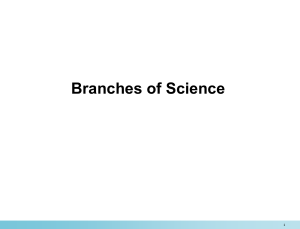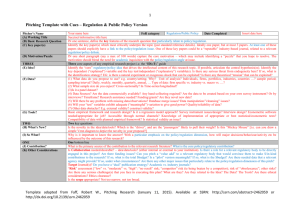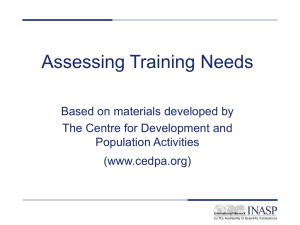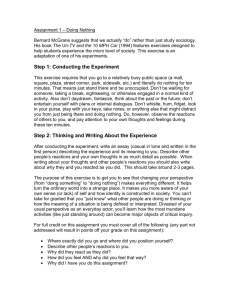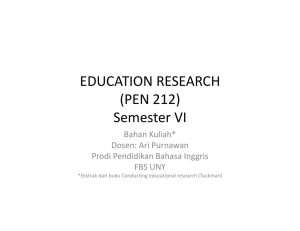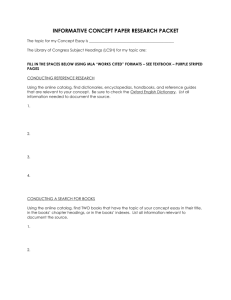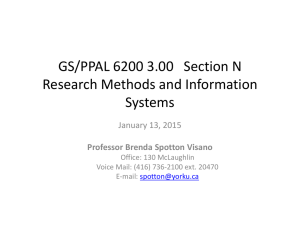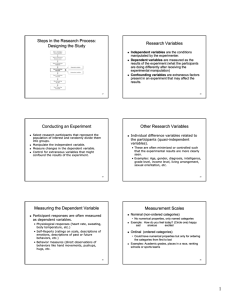Action Research
advertisement
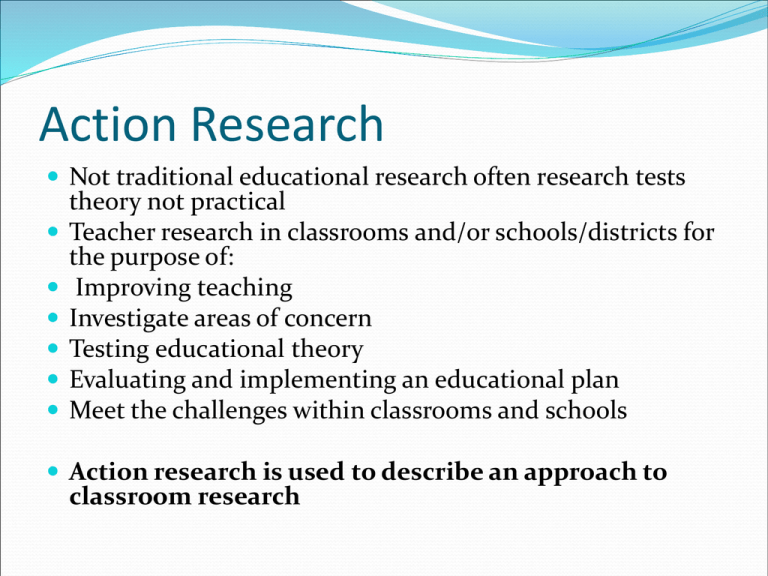
Action Research Not traditional educational research often research tests theory not practical Teacher research in classrooms and/or schools/districts for the purpose of: Improving teaching Investigate areas of concern Testing educational theory Evaluating and implementing an educational plan Meet the challenges within classrooms and schools Action research is used to describe an approach to classroom research A few reasons to do action research… Help you build a reflective practice based on proven ideas or techniques Allow you to try new ideas and reliably assess their effectiveness It will help you build confidence in your managerial or instructional decisions It will contribute to the professional culture of teaching at your school It can create meaningful and lasting change in order to improve student achievement Levels of Action Research Individual for classroom Group of teachers for department Teachers, administrators, and other stakeholders to affect change in larger school community Action Research History Kurt Lewin(1946) credit with development of concept of action research Evolved and influenced by Kemmis(1983), Ebbutt (1985), Elliott (1991), Hopkins (1985) and others… Conducting Action Research Steps Identify the question, issue or problem Conduct a literature review Define a solution Apply the solution and collect the data Analyze your findings Report your findings Take ACTION How to Get Started.. Identify the Question, Issue or Problem Decide on a FOCUS Find your professional self…some guiding questions may be… What are your broad interests in teaching? What are your specific interests? What questions are manageable? What are you passionate about? Is there a problem or question that you would like an answer to or as a future teacher, administrator, policy maker, researcher and how will an answer to your question or idea help you do a better job? Literature Review http://www.youtube.com/watch?v=t2d7y_r65HU&featu re=related What is a Literature Review? A “lit review” done early in the research process is the review of the research literature related to the problem or question posed? Once the problem or question has been identified, information is needed about the problem so that it can be placed in the proper context and the research can proceed… Sources of Information Studies published in books, journals, periodicals, technical reports, and academic theses and dissertations available either in print or online through the library’s electronic sources. Note: one distinction made between references is whether they are primary or secondary sources. A primary source is a report, book, article written by the person who conducted the research. Secondary sources are written by someone at least one step removed from the research. Assembling and Summarizing Information Once you locate and review the sources from the literature search, then you must consider the question “What should I do with this information?” First, you need to determine if the content of the source is relevant to your research problem or question? Try to stay focused… If is not relevant, delete it! Interpreting and Using Information Once you review your sources, you can skim them to get an overview. From this overview, you can make a decision on whether this information is relevant to your research problem or question… Writing the Review Now the information that you have reviewed and synthesized can be put into the review of the literature… For your literature review… it should be from 10 to 15 pages with a minimum of 10 references. Referencing When information is reported from a source, it must be adequately referenced. Please use APA format. Referencing can be done in a number of ways, a reference list is limited to references sited in your report…please use References for your report. A bibliography may also include references for background information or further reading Conducting Action Research Steps Identify the question, issue or problem Conduct a literature review Define a solution Apply the solution and collect the data Analyze your findings Report your findings Take ACTION Conducting Action Research Steps Further Defined At this point, You have identified the question, issue or problem Conducted a literature review search Reviewed the available literature and written a Literature Review on your question of interest What have you discovered? Conducting Action Research Steps Further Defined Define a solution Apply the solution and collect the data Analyze your findings Report your findings Take ACTION What do we mean by Define a Solution Next Step? Research Design Quantitative or Qualitative? Action research is defined as research conducted at the local level, conducted by a practitioner, focused on solving a particular problem it can be either… Research Methods Sampling procedures Data collection procedures The Nature of Educational Research Research is empirical. Research is systematic. Research should be valid. Research should be reliable. Research can take on a variety of forms. Research is empirical Educational research is characterized as empirical, because empiricism is the concept that all knowledge is derived from sense experience. Information takes the form of data, which can include test scores, field notes, responses to questionnaire items, etc… Research is systematic Based on the scientific method, there are five steps 1. Identify the problem 2. Review the information 3. Collect data 4. Analyze data 5. Draw conclusions within the framework of your study Research should be valid Validity is when something should be based on fact or evidence Internal validity is the extent to which results can be interpreted accurately External validity is the extent to which results can be generalized to a population, situations and conditions..in action research we are not concerned about this area… Research should be reliable Reliability of research concerns the replicability and consistency of the methods, conditions, and results. Research can take on a variety of forms Basic and applied research The primary purpose of basic research is the extension of knowledge The primary purpose of applied research is the solution of an immediate, practical problem… Action Research One type of applied research is action research …this is what we are doing! Action research is often conducted by teachers, administrators or other educational professionals for solving a specific problem or for providing information for decision making at the local level. Action research is less rigorous in terms of design and methodology then other educational research… Research Methods Describe your sampling and data collection procedures Identify your instrument, test, interview, questionnaire, survey… How will you measure? What about validity and reliability? How will you analyze the data? Important to think about ahead of time, if you are using human subjects you need to go through an institutional review board. Data Collection Measuring instruments must be identified and/or developed If the data is descriptive in nature, you must take field notes You can collect data by doing interviews or observations If you conduct a survey, you need to determine what measuring instruments you will use, i.e. questionnaires, standardized tests Think ahead…about preparing the data you collect for analysis Next Step Defining your solution…… Collecting your data……..
